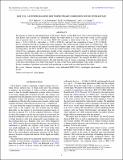KOI 1224: A FOURTH BLOATED HOT WHITE DWARF COMPANION FOUND WITH KEPLER
Author(s)
Breton, Rene P.; van Kerkwijk, M. H.; Carter, Joshua Adam; Rappaport, Saul A
DownloadBreton-2012-KOI 1224_ A fourth b.pdf (1.512Mb)
PUBLISHER_POLICY
Publisher Policy
Article is made available in accordance with the publisher's policy and may be subject to US copyright law. Please refer to the publisher's site for terms of use.
Terms of use
Metadata
Show full item recordAbstract
We present an analysis and interpretation of the Kepler binary system KOI 1224. This is the fourth binary found with Kepler that consists of a thermally bloated, hot white dwarf in a close orbit with a more or less normal star of spectral class A or F. As we show, KOI 1224 contains a white dwarf with T [subscript eff] = 14, 700 ± 1000 K, mass = 0.22 ± 0.02 M [subscript ☉], and radius = 0.103 ± 0.002 R [subscript ☉], and an F-star companion of mass 1.59 ± 0.06 M [subscript ☉] that is somewhat beyond its terminal-age main sequence. The orbital period is quite short at 2.69802 days. The ingredients that are used in the analysis are the Kepler binary light curve, including the detection of the Doppler boosting effect; the NUV and FUV fluxes from the GALEX images of this object; an estimate of the spectral type of the F-star companion; and evolutionary models of the companion designed to match its effective temperature and mean density. The light curve is modeled with a new code named Icarus which we describe in detail. Its features include the full treatment of orbital phase-resolved spectroscopy, Doppler boosting, irradiation effects, and transits/eclipses, which are particularly suited to irradiated eclipsing binaries. We interpret the KOI 1224 system in terms of its likely evolutionary history. We infer that this type of system, containing a bloated hot white dwarf, is the direct descendant of an Algol-type binary. In spite of this basic understanding of the origin of KOI 1224, we discuss a number of problems associated with producing a system with an orbital period this short.
Date issued
2012-03Department
MIT Kavli Institute for Astrophysics and Space ResearchJournal
Astrophysical Journal
Publisher
IOP Publishing
Citation
Breton, R. P., S. A. Rappaport, M. H. van Kerkwijk, and J. A. Carter. “ KOI 1224: A FOURTH BLOATED HOT WHITE DWARF COMPANION FOUND WITH KEPLER .” The Astrophysical Journal 748, no. 2 (March 14, 2012): 115. © 2012 The American Astronomical Society
Version: Final published version
ISSN
0004-637X
1538-4357